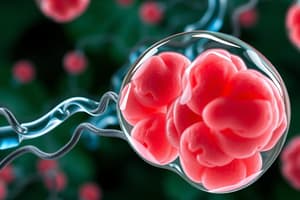Podcast
Questions and Answers
What is formed upon one-electron reduction of hydrogen peroxide?
What is formed upon one-electron reduction of hydrogen peroxide?
- Water molecule
- Hydroxyl anion
- Superoxide ion
- Hydroxyl radical (correct)
Which of the following statements correctly describes a characteristic of molecular oxygen?
Which of the following statements correctly describes a characteristic of molecular oxygen?
- It is not a radical.
- It has one unpaired electron.
- It has two unpaired electrons.
- It is a diradical. (correct)
Which reactive species is considered a radical?
Which reactive species is considered a radical?
- H2O
- Hydroxyl anion
- Hydrogen peroxide
- Superoxide ion (correct)
In the context of oxidative stress, which components are sensitive to damage by reactive species?
In the context of oxidative stress, which components are sensitive to damage by reactive species?
Which radical is formed through the reduction of hydrogen peroxide?
Which radical is formed through the reduction of hydrogen peroxide?
Which of the following is NOT classified as a free radical?
Which of the following is NOT classified as a free radical?
What type of ion is the superoxide ion considered to be?
What type of ion is the superoxide ion considered to be?
What best describes the nature of hydroxyl radical?
What best describes the nature of hydroxyl radical?
What is the role of specific antioxidant defenses?
What is the role of specific antioxidant defenses?
How do enzymes that remove hydrogen peroxide function?
How do enzymes that remove hydrogen peroxide function?
What is a clinical implication of the mechanism associated with a-tocopherol transfer protein?
What is a clinical implication of the mechanism associated with a-tocopherol transfer protein?
What is the synergistic effect between vitamins E and C?
What is the synergistic effect between vitamins E and C?
What role do free radicals play in oxidative eustress?
What role do free radicals play in oxidative eustress?
What is Amyotrophic Lateral Sclerosis (ALS) linked to regarding SOD1?
What is Amyotrophic Lateral Sclerosis (ALS) linked to regarding SOD1?
What does the term 'oxygen paradox' refer to?
What does the term 'oxygen paradox' refer to?
What is one function of the oxygen-dependent electron transport chains?
What is one function of the oxygen-dependent electron transport chains?
What is the primary role of lipid peroxyl radicals in oxidative stress?
What is the primary role of lipid peroxyl radicals in oxidative stress?
How does hydroxyl radical contribute to DNA damage?
How does hydroxyl radical contribute to DNA damage?
What is a consequence of the oxidation of nucleobases due to hydroxyl radicals?
What is a consequence of the oxidation of nucleobases due to hydroxyl radicals?
What reaction is responsible for the formation of hydroxyl radicals in biological systems?
What reaction is responsible for the formation of hydroxyl radicals in biological systems?
Which cellular component is most directly affected by lipid peroxyl radicals?
Which cellular component is most directly affected by lipid peroxyl radicals?
What mechanism is involved in the oxidative damage to DNA?
What mechanism is involved in the oxidative damage to DNA?
What is a potential protective mechanism cells use against oxidative stress?
What is a potential protective mechanism cells use against oxidative stress?
Where is catalase particularly abundant in mammalian cells?
Where is catalase particularly abundant in mammalian cells?
Which of the following is NOT typically considered an antioxidant?
Which of the following is NOT typically considered an antioxidant?
What is the primary function of catalase in mammalian cells?
What is the primary function of catalase in mammalian cells?
At what rate can catalase decompose hydrogen peroxide molecules?
At what rate can catalase decompose hydrogen peroxide molecules?
What is the mechanism by which catalase decomposes hydrogen peroxide?
What is the mechanism by which catalase decomposes hydrogen peroxide?
What is the byproduct of catalase's reaction with hydrogen peroxide?
What is the byproduct of catalase's reaction with hydrogen peroxide?
In which cellular structure is catalase predominantly located?
In which cellular structure is catalase predominantly located?
Which of the following statements about oxidative stress is true?
Which of the following statements about oxidative stress is true?
Which neurological disorder is associated with the SOD1 protein?
Which neurological disorder is associated with the SOD1 protein?
Which gene is associated with cytoprotective mechanisms?
Which gene is associated with cytoprotective mechanisms?
What type of study confirmed the safety and efficacy of omaveloxolone?
What type of study confirmed the safety and efficacy of omaveloxolone?
In what month and year was omaveloxolone approved by the FDA?
In what month and year was omaveloxolone approved by the FDA?
Which of the following is a component of the cytoprotective mechanisms indicated?
Which of the following is a component of the cytoprotective mechanisms indicated?
What does GPx stand for in the context of cytoprotective factors?
What does GPx stand for in the context of cytoprotective factors?
Which enzyme is referred to as Heme Oxygenase-1?
Which enzyme is referred to as Heme Oxygenase-1?
What is a key function of Peroxiredoxins?
What is a key function of Peroxiredoxins?
What type of genes are activated by Nrf2?
What type of genes are activated by Nrf2?
Study Notes
Oxygen Paradox
- Oxygen is essential for energy production in most organisms.
- Oxygen is used in the electron transport chains of mitochondria in eukaryotic cells.
- The oxygen paradox is that the same oxygen needed for life can also lead to damaging processes.
- The oxygen paradox refers to the highly reactive nature of oxygen.
- This is due to the tendency of oxygen to form free radicals and oxidants, which can damage the cells.
Free Radicals and Oxidative Stress
- Oxygen radicals are characterized by having one or more unpaired electrons.
- Oxygen radicals are highly reactive and can damage cells.
- Examples of oxygen radicals: superoxide anion, hydrogen peroxide, and hydroxyl radical.
- All cell components (lipids, nucleic acids, proteins, and carbohydrates) are susceptible to damage by reactive species.
- Oxidants can cause damage to cells by various mechanisms, including:
- Lipid peroxidation.
- DNA oxidation.
- Protein oxidation.
Antioxidant Defenses
- Cells have developed various mechanisms to protect themselves against the damaging effects of oxidants.
- There are various categories of antioxidant defense mechanisms:
- Enzymes:
- Superoxide dismutase (SOD) catalyzes the conversion of superoxide into hydrogen peroxide and oxygen.
- Catalase is an enzyme that breaks down hydrogen peroxide into water and oxygen.
- Glutathione peroxidase is an important enzyme involved in detoxifying hydrogen peroxide and lipid peroxides.
- Small-molecule antioxidants: these act as scavengers of free radicals. Examples include:
- Vitamin C
- Vitamin E
- Glutathione
- Enzymes:
Amyotrophic Lateral Sclerosis (ALS)
- ALS is a neurodegenerative disease characterized by the progressive loss of motor neurons.
- Mutations in the SOD1 gene have been implicated in the development of ALS.
- SOD1 is an enzyme that plays a critical role in the removal of toxic superoxide radicals.
- It is thought that SOD1 mutations can make the enzyme dysfunctional, leading to the accumulation of superoxide radicals in the nervous system and contributing to neuronal damage.
Alpha-Tocopherol Transfer Protein (TTP)
- TTP is an enzyme involved in the transport of vitamin E (alpha-tocopherol) to various tissues.
- TTP deficiency can lead to impaired vitamin E transport, resulting in vitamin E deficiency.
- This deficiency can lead to several health problems, including neurological disorders.
Synergism between Vitamin E and C
- Vitamin E and C have a synergistic effect where vitamin E protects lipids from oxidation, while vitamin E helps regenerate the reduced form of Vitamin C from its oxidized form.
Oxidative Eustress and Stress
- Oxidative eustress is the beneficial effects of free radicals and oxidants on health.
- Oxidative stress occurs when the production of oxidants overwhelms the body's antioxidant defenses.
- Oxidative stress is linked to various diseases, including heart disease, cancer, aging, and neurodegenerative disorders.
Studying That Suits You
Use AI to generate personalized quizzes and flashcards to suit your learning preferences.
Related Documents
Description
Explore the fascinating dual role of oxygen in life through this quiz on the oxygen paradox and its relationship to free radicals. Learn how oxygen is essential for energy production yet can also lead to oxidative stress and cellular damage. Understand the mechanisms of oxidative damage and the importance of antioxidants.




